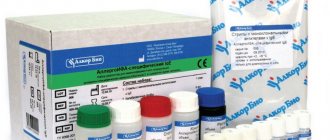What symptoms require testing?
Stool examination is prescribed for digestive disorders, which are characterized by certain symptoms:
Clinical manifestations are directly related to protein deficiency ─ excessive reproduction of conditionally pathogenic intestinal flora. Feces change color, consistency and smell. There are viscous, mushy, with fragments of undigested food
The color of the stool is gray or with a green tint and has a greasy appearance. In rare cases, patients experience polyfecalia ─ intense diarrhea, the number of bowel movements per day is 1000 g or more. Dyspeptic symptoms ─ bloating due to increased gas production, heaviness after eating, sometimes nausea and heartburn. General (subjective) signs ─ weakness, lethargy, decreased ability to work, distracted attention, slight increase in body temperature (no more than 37.5°C), dehydration, loss of appetite, loss of body weight, behavioral disturbances. Due to lack of protein, edema develops. Vitamin K deficiency provokes the development of anemia and the formation of small subcutaneous hemorrhages.
Types
Pancreatic enzyme, depending on its functions, is divided into two types:
- Elastase-1, or pancreatic. It is produced in the secretory (acinar) cells of the gland and is delivered into the intestinal lumen along with other enzymes in the form of proelastase. There, when interacting with trypsin, it is converted into elastase and participates in the breakdown of protein products. This enzyme is specific and is not detected in other tissues or organs.
- Elastase-2, or serum. An enzyme that, during inflammatory processes, penetrates from the pancreas into the blood through destroyed cell membranes. During an acute pathological process, serum elastase levels increase significantly. This is determined by a blood test. The concentration begins to increase within 6 hours from the onset of the disease, reaching its peak on the second day. The enzyme has a long half-life, so it remains in the blood for up to 5 days, sometimes more than a week.
Algorithm for collecting biomaterial
- Stool collection is performed in the morning after emptying the bladder and hygienic washing of the external genitalia and anal area.
- After the act of natural defecation, feces are collected with a special spatula in a plastic container. Glassware for analysis can be freely purchased at any medical center. institution.
The amount of feces required for research is up to 30% of the container volume.
- The following information is indicated on the container: name and age of the patient, date and time of stool collection.
- The container with the biomaterial is sent to the laboratory immediately after collection. If it is not possible to do this immediately, then the material can be stored in the refrigerator for about 5-8 hours at a temperature of 4-6°C.
Elastase is a special class of hydrolases that is practically intact for other proteinases. These enzymes are found in granulocytes, macrophages, and lysosomal granules. In addition, this class of hydrolases is involved in digestion. Pancreatic elastase is produced by exocrine cells of the pancreas in the form of an inactive form of pancreaticopeptidase E. Changes in the level of pancreatic elastase in the stool invariably indicate the presence of a pathological process in the pancreas.
Serum elastase
If there are suspicions of disorders of the gastrointestinal tract and pancreas in a child or adult, the analysis can be done on the basis of stool or blood serum. A serum elastase test is prescribed in case of abdominal pain in a patient.
However, it comes in two types:
- Pancreatic elastase 1. This is an enzyme whose molecular weight is 30,000. The substance is produced by the pancreas and circulates freely throughout the body through the blood. Or it may circulate with an inhibitor that inhibits enzyme activity.
- Pancreatic elastase 2. Its molecular weight is 25,000. An analysis is recommended if nephritis, arthritis or emphysema is suspected.
Along with examining blood and stool for elastase, doctors may prescribe an analysis of another enzyme - pancreatic lipase. This is a pancreatic enzyme whose task is to break down fatty acids, fats and glycerol.
The role of elastase in the human body
A stool test for elastase is recommended for everyone, regardless of age or gender, as well as the current state of health; a timely study can prevent problems with the gastrointestinal tract.
Elastase (coprological elastase, Pancreatopeptidase E) is one of the few enzymes in the human body that does not change when passing through the intestines. Therefore, by analyzing stool for pancreatic elastase, it is possible to assess the current state of the pancreas, the main function of which is the synthesis of most enzymes that enter the intestines along with pancreatic juice.
The task of elastase is to break down protein, elastic and other proteins that a person receives with food.
Elastin has, in fact, only one analogue - collagen. However, collagen is found exclusively in foods of animal origin, while elastin is found in animal and plant products. Regular consumption of foods containing this enzyme has a good effect on the skin, hair, and gastrointestinal tract.
Elastase will be present in feces in children and adults in any case. The question is whether a person’s body produces enough enzyme or whether it is less than normal. If the value is increased or decreased, you should consult your doctor and take appropriate action.
You can get tested for pancreatic elastase at any diagnostic center, since this test is included in the list of standard tests.
Preparation
The study of elastase concentration does not require special preparation. The patient does not need to follow a strict diet or stop treatment with enzyme preparations, since substances of animal origin do not affect the result of scatological analysis. The list of drugs that must be excluded before taking biomaterial is quite small.
When to stop taking medications before getting tested?
3-4 days before the elastase test, you must stop taking medications such as:
- laxatives, including petroleum jelly and castor oil;
- medications that affect intestinal contractions (Belladonna, Pilocarpine, etc.);
- rectal suppositories and ointments;
- other medications that affect the secretory ability of the pancreas.
It is advisable to limit the consumption of fatty, fried, smoked, spicy and overly salty foods. It is prohibited to take biomaterial after an enema and irrigoscopy. Preparations of bismuth, barium and magnesium sharply reduce the diagnostic value of the analysis.
Stool analysis for elastase preparation and collection of material
To find out about the elastase content, you need to take a stool test.
This will give an idea of whether the pancreas is functioning properly and whether it is producing the necessary enzymes in the quantities that are optimal for normal digestion. The test can be taken at any clinic. Before taking the test, you must visit a doctor. The patient should not stop taking medications if he is undergoing any therapy. You must collect the feces yourself in a plastic container. It can be purchased at any pharmacy or hospital
Containers for urine and feces differ, you need to pay attention to this, since in the second case there is a special spatula inside for collecting material, which facilitates the procedure
The container must be filled to 1/3 of its volume. In this case, you need to wash yourself and ensure that genital secretions and urine do not get into the biomaterial. Feces can be collected in the morning or evening and then stored in the refrigerator at a temperature of 2 to 6 degrees. Under favorable conditions, enzymes remain unchanged for quite a long time, so you can rest assured that the results are correct. The laboratory performs an enzyme immunoassay, which gives a complete picture of the content and quantity of enzymes in the stool.
This test is so important because elastase levels in stool are not affected by gender, age, medications, or other conditions that typically confound the results of other tests. The biomaterial can be preserved for a long time, while the enzymes do not lose their properties. It is elastase that is not able to change in the colon, unlike other pancreatic enzymes, so this study is actively used by doctors.
Pancreatic elastase: what is it and what is the norm?
Pancreatic elastase is an enzyme produced by the cells of the pancreas.
It breaks down elastin, which is part of connective tissue. After synthesis, the enzyme enters the duodenum, where it is activated by trypsin. The enzyme is not destroyed in the intestines, but is released naturally. Determination of elastase levels serves as a non-invasive diagnostic method for assessing pancreatic function. The diagnostic test is the “gold” standard for detecting pancreatitis and other organ diseases.
What is pancreatic elastase
Pancreatic elastase belongs to the class of acidic enzymes. To understand what it is, you need to understand the physiology of the pancreas. The exocrine part of the organ synthesizes an inactive proenzyme, which enters the small intestine as part of the juice. Activation occurs under the influence of trypsin, which is also produced in the pancreas.
This pancreatic enzyme is a highly active substance. It is not broken down in the alkaline environment of the small intestine, but is excreted along with feces. Pancreatic elastase in feces is an indicator of pancreatic diseases.
Its level is used to judge the functional activity of the organ. The analysis is specific and sensitive. Performed in all laboratories equipped with an ELISA analyzer. The non-invasiveness of the method allows its use in pediatric practice.
The test helps confirm cystic fibrosis and begin treatment immediately.
Types of Elastase
The enzyme circulates in the body in two fractions, each of which has its own characteristics:
- Pancreatic elastase 1 is synthesized in the exocrine part of the gland. As part of the pancreatic secretion, it enters the lumen of the duodenum, where the process of biochemical activation takes place. Later it performs digestive functions. Find elastase 1 in feces. The enzyme is specific only for pancreatic cells. It is impossible to determine it in other tissues.
- Elastase 2 (serum). The enzyme enters the systemic circulation from destroyed pancreatic cells. Acute pancreatitis leads to an increase in the concentration of this fraction. The enzyme is determined in the blood. Already 5-6 hours after the onset of the first symptoms, its level increases, reaching a maximum after 48 hours. Elastase is resistant to biochemical factors. High concentrations in the blood remain for 3 to 10 days.
Both pancreatic enzymes are determined for a comprehensive diagnosis of the organ. However, the indications for their study differ.
When is the test ordered?
A pancreatic elastase test is prescribed if pancreatic dysfunction is suspected.
The analysis is a standard technique for assessing the condition of the exocrine pancreas. Prescribed for diseases of the digestive system that tend to spread. For example, cholecystitis can provoke pancreatitis and gastritis.
Diseases associated with chronic organ failure:
- suspected cystic fibrosis;
- pancreatitis;
- gallstones;
- severe diabetes;
- lactase deficiency;
- Crohn's disease (autoimmune intestinal disease);
- suspected tumor in the pancreas;
- damage to the pancreas;
- complaints of abdominal pain;
- yellowness of the skin;
- causeless weight loss;
- cysts identified by ultrasound.
Be sure to investigate for diseases associated with damage to the exocrine glands (for example, mumps).
How to prepare and collect material
The material to be detected is feces. For analysis, 1 gram of feces is enough, but it is recommended to collect at least 10 g.
A few days before the test you should:
- stop taking medications that stimulate intestinal motility (belladonna extract, Pilocarpine, Domperidone);
- do not use rectal suppositories;
- stop taking laxatives, including Vaseline and castor oil;
- do not use drugs with a fixing effect (Loperamide);
- do not do douching or enemas.
The diet limits foods that put stress on the pancreas (fatty, spicy, spicy).
The material is not examined during menstruation, or after irrigography (an X-ray method of visualizing the intestines using contrast).
Feces are collected immediately after defecation. Before going to the toilet, you need to urinate and wash your perineum. A special plastic container is used to collect the material.
Using a spatula, collect a sufficient amount (1/3 of the vessel) of feces. Afterwards, be sure to tightly close the lid. It is advisable to send the jar to the laboratory immediately after collection.
The material can be stored in the refrigerator at a temperature of 4-6°C for no more than 6 hours.
Decoding the results: norm and reasons for deviations
A stool test for pancreatic elastase is prescribed by a gastroenterologist. The doctor conducts a comprehensive assessment of the indicators. Sometimes it is necessary to supplement laboratory analyzes with data from instrumental studies. Determination of enzyme levels is carried out simultaneously with ultrasound of the pancreas. This way the doctor gets a complete picture of the disease.
Norm of pancreatic elastase in feces
The normal level of pancreatic elastase is >200 mcg/1 g of material. Different laboratories give different standard values. The indicators depend on the nature of the study (mono- or polyclonal, enzyme-linked immunosorbent assay), as well as on the characteristics of the analyzer. The enzyme is also determined by the sensitivity of the equipment.
Reduced quantity
The degree of pancreatic insufficiency depends on the amount of pancreatic elastase. At
Source: https://podzhelud.ru/podzh/pankreaticheskaya-elastaza
Normal enzyme levels in biomaterial
Elastase-1 levels in a newborn baby are slightly lower than normal, but by two weeks of age they reach normal levels. Only a highly qualified specialist should analyze the data obtained. The results are deciphered as follows.
- An EP value > 200 µg/g indicates normal pancreatic function. The higher the value, the better the function of this organ (when pancreatic elastase is > 500 mcg/g or just 500 - good).
- A value of 100-200 mcg/g means mild pancreatic insufficiency.
- ED value
That is, if the indicator is higher than normal, it will not have any clinical significance. But when the study reveals an insufficient level of elastase, it is necessary to begin treatment.
“Gold standard” in the diagnosis and assessment of exocrine pancreatic function. An indicator reflecting the state of the exocrine function of the pancreas. Elastase is a proteolytic enzyme, with m.v. 28,000 Yes, which, unlike other proteolytic enzymes, is capable of breaking down elastin, which is part of connective tissue. There are pancreatic and leukocyte elastase. Pancreatic elastase (elastase 1) is synthesized in the pancreas and excreted as proelastase along with other enzymes into the duodenum, where it is converted into elastase by the action of trypsin. Elastase 1 is not degraded in the intestine, so its content in feces is used as an indicator of exocrine pancreatic function. The test is specific for human pancreatic elastase 1, therefore the supply of exogenous elastase (animal origin) does not affect the results of the study, there is no need to interrupt treatment before the test. The diagnostic sensitivity and specificity of the test, which exceed 90%, as well as its convenience for the patient, make this method an almost ideal test, the “gold standard” for diagnosing disorders of exocrine pancreatic function. The content of elastase 1, low in newborns, reaches adult levels by 2 weeks of age. Pancreatic elastase can enter the blood in increased quantities in case of inflammation of the pancreas (pancreatitis)
Determination of elastase 1 in feces is especially important in the diagnosis of cystic fibrosis, a hereditary disease in which the structure and function of the cells lining the excretory ducts of the exocrine glands are disrupted, which leads to damage to the lungs, gastrointestinal tract, disruption of digestive processes (in this case, there is a significant decrease in the content of pancreatic elastase in feces). Only early diagnosis can prevent the death of this disease.
Determination of pancreatic elastase in stool is valuable for confirming or excluding the presence of exocrine pancreatic insufficiency due to chronic pancreatitis, pancreatic tumor, cholelithiasis or diabetes (moderate decrease in concentration).
What are the positive and negative qualities of enzyme testing?
Detection of elastase indicators has its advantages and disadvantages. The positive properties of the enzyme include:
- accurate detection of pancreatic insufficiency;
- ease of definition;
- no destruction occurs during movement through the intestines;
The diagnosis of chronic obstructive pancreatitis should be based on the presence of morphological abnormalities that affect the excretory system. Chronic pancreatitis is generally classified into developmental stages that do not correspond to potential clinical severity, since an acute flare of pancreatitis may be associated with greater clinical severity than the deterioration of exocrine function characteristic of advanced stages.
Stage A represents the initial phase of chronic pancreatitis, where there were no complications or functional impairment. It is characterized by outbreaks of acute pancreatitis or pancreatic pain of any type and intensity. Treatment should be aimed at eliminating etiological factors, improving symptoms, eliminating complications and preventing disease progression.
Prepared biomaterial for laboratory research
- does not affect the composition of food;
- clear correlation with pain during pancreatitis - the greater the pain, the less enzyme in the stool;
- the material in the jar can be stored for a week without special conditions.
However, not everything is smooth when determining enzymatic deficiency. There are also negative nuances:
- if the patient has diarrhea, the result will be incorrect;
- low specificity for pancreatic diseases;
- for mild disorders, the sensitivity of the analysis is low;
- there is a connection only with clinical manifestations, but not with structural ones;
- has no diagnostic value if replacement therapy is necessary;
- high price;
- The analysis is only planned, it takes several days.
Elastase testing is mandatory for cystic fibrosis
In most cases, the importance of elastase is secondary. With minor changes in the pancreas, this enzyme should not be thoroughly examined. In most regional centers, enzyme testing is not carried out at all. It is necessary to assess the severity of cystic changes in the pancreatic zone in cystic fibrosis.
Normal indicators and deviations
As a result of the analysis, the indicator under study can be called pancreatic elastase, elastase 1 or pancreaticopeptidase E.
Normal in adults
The normal value for fecal elastase is 200 to 500 mcg/g. With a result in the range of 100-200 mcg/g, mild to moderate degrees of pancreatic excretory insufficiency are detected.
In children
The normal content of elastase in feces does not depend on the age and gender of the patient (with the exception of the value in newborns).
A decrease in the secretory ability of the gland in a child can most likely be caused by a change in diet or intolerance to certain foods (celiac disease, hypolactasia).
Values in newborns
In newborns, the level of elastase is physiologically reduced during the first 2 weeks of life. In older children, the enzyme content corresponds to adult levels.
Elastase in feces 80
Severe degrees of secretory glandular insufficiency, in which results below 80 mcg/g are observed, can be caused by reasons such as:
- chronic pancreatitis;
- intolerance to gluten (celiac disease) and lactose (hypolactasia);
- diabetes;
- cystic fibrosis;
- Crohn's disease;
- cancer of the gland and excretory ducts;
- cholelithiasis;
- hepatitis;
- dysfunction of the glandular system with replacement of functional connective tissue;
- destruction of exocrine cells.
A false decrease can be observed when taking drugs that inhibit intestinal motility.
Pathologies of the pancreas, which are accompanied by a severe degree of secretory insufficiency, are not asymptomatic. They are manifested by nausea, vomiting, foaminess and discoloration of stool, constipation, the appearance of blood, mucus and particles of undigested food during bowel movements, severe abdominal pain, sour or putrid odor of intestinal gases.
More than 500
Elevated levels of elastase are of less concern to specialists. If the result is from 500 to 700 μg/g, observation and re-monitoring of the enzyme concentration is recommended.
If the value exceeds 700 mcg/g, the patient is prescribed further examination to confirm or exclude acute pancreatitis, cholelithiasis, cancerous tumors and metastases in the pancreas.
The cause of a false result may be the use of laxatives.
Pathology of the gland, which is accompanied by highly elevated levels of elastase, is manifested by symptoms such as weakness, diarrhea, bloating and abdominal pain, anemia due to deficiency of B vitamins, weight loss and bone fragility.
If there are deviations, the doctor may order a repeat test to rule out a laboratory error.
Indications for the purpose of analysis
Pancreatic elastase 1 in feces makes it possible to establish the cause of the pathology and is determined in the following cases:
- Abdominal pain, heaviness in the epigastrium after eating (abdominal syndrome).
- Exocrine pancreas insufficiency, including in chronic pancreatitis and cystic fibrosis, in order to control the exocrine potential of the gland, especially in patients with endocrine insufficiency (type 1 and 2 diabetes) in order to prevent the development of acute pancreatitis. In this case, the reliability of the indicator exceeds 93%; fluctuations in the norm in a child (from the first month of life) and an adult range from 200 to 8000 mcg/g.
- A tumor process in the body of a benign or malignant nature.
- Monitoring the effectiveness of treatment of pancreatic enzyme deficiency.
- Intestinal flatulence (constant bloating for no apparent reason).
- Dyspepsia or constipation (stool instability).
- Yellowness of the skin and sclera as a result of impaired bile outflow (obstructive jaundice).
- Sudden weight loss (up to cachexia).
- Changes in stool (color, smell, inclusions).
- Lactase deficiency (lack of ability to absorb food protein).
- Pancreas injuries, surgical interventions on the gland.
- Fibrocystic pancreas.
There are no contraindications for testing. The results of the analysis are deciphered by a gastroenterologist or doctors of related specialties: pediatrician, therapist, surgeon, endocrinologist, oncologist, dermatologist.
Study preparation and execution
Biological material for examining a patient for pancreatic elastase is feces. Recommended volume for analysis is 5-10 g.
Since the enzyme is associated with food intake, the results of the analysis directly depend on what the person took. Therefore, preparation is necessary before donating stool. Three days before the study, you need to stop taking medications based on oils (laxatives), pilocarpine (increases the secretion of the digestive glands, increases the tone of the intestinal walls), belladonna (relaxes the smooth muscles of the gastrointestinal tract).
To obtain accurate readings, you should not do cleansing or medicinal enemas before taking the test. X-ray examinations using a contrast agent (barium) are contraindicated.
It is best to perform a stool test for pancreatic elastase in the first half of the day. On the morning of the test, collect the stool in a clean plastic or glass container using a spatula, sign it with your information, and send it to the laboratory. You can collect the evening portion of feces and put it in the refrigerator overnight.
To determine the quantitative content of elastase in feces, an immunological research method is used. It is based on the antibody-antigen reaction. The standard scatological test includes monoclonal bodies that immediately recognize the pancreatic enzyme. This method is a priority because it has high sensitivity and specificity.
This means that the test:
- accurately determines chronic secretory elastase deficiency;
- in 93% of cases it registers chronic pathology of the pancreas;
- detects the disease at the initial stage with mild and moderate forms of the course.
Changing the activity of pancreatic elastase is a very slow process. Its study is carried out no more than 1-2 times a year, since significant changes in indicators will not occur during this period.
How is elastase content determined?
If there are suspicious symptoms of insufficient digestion of protein mass, the content of pancreatic elastase in the stool is determined. Standard indicators of normality and pathology of this enzyme are as follows:
- the norm is at least 200 mcg in stool weighing 1 gram, while the upper figure is not so important, it can be more than 500 mcg;
- minor exocrine insufficiency - from 100 mcg in stool weighing 1 gram and up to 200 mcg;
- severe proteolytic deficiency - less than 100 mcg per 1 gram of feces.
The material for studying the enzyme is feces. A small amount is enough, no more than 10 grams.
The occurrence of flares of acute pancreatitis, pseudocysts, or inflammatory masses is part of the natural history of the disease. Complications considered: complex pseudocysts; stenosis of the biliary tract, duodenum or colon; venous thrombosis; pseudoaneurysms; intracastomic, intra-abdominal or digestive hemorrhage; internal or external fistulas; ascites and pancreatic cancer.
However, a small number of patients may remain asymptomatic or have very mild symptoms before complications occur. In addition, the diagnosis is not easy to establish in the initial stages or in the absence of typical morphological changes. Histologically, fibrosis and atrophy of the acinan are required, accompanied by a variable component of chronic inflammatory infiltrate. Affection is usually corrected. During acute outbreaks of the disease, polymorphonuclear cells are identified.
Material for enzyme research - feces
The norm and pathological values of this analysis depend on some substances that a person can use in everyday life. So, 72 hours before the expected determination of elastase, the following measures should be taken:
In clinical practice, due to difficulties in obtaining pancreatic tissue samples, histological examination is rarely available. Both morphological changes and exocrine insufficiency occur with varying degrees of involvement; they do not occur in parallel and are only pathognomonic in later stages.
Morphological changes are identified with greater sensitivity by endoscopic ultrasound, but both magnetic resonance imaging with contrast and infusion secretory and multidetector computed tomography identify morphological changes of the pancreas with good sensitivity. In routine clinical practice, tests of exocrine pancreatic function are limited to fecal elastase, since very few centers use other more sensitive function tests, such as the endoscopic secretion test.
- stop using laxatives, especially oil-based ones;
- do not use medications based on pilocarpine and belladonna;
- do not do enemas;
- do not perform diagnostic X-ray procedures with barium;
- refrain from anal sex.
The study of the activity of this enzyme should not be carried out more than 2 times a year, since significant changes will not occur over a six-month period.
Therefore, the diagnosis of chronic pancreatitis is subject to periodic review. Consensus conferences in Marseille, Rome and Cambridge adopted the Rosemont diagnostic criteria based on endoscopic ultrasound and the Japanese Pancreatic Society study with a multidisciplinary orientation. However, the application of these criteria for the diagnosis of chronic pancreatitis is not entirely satisfactory.
Autoimmune pancreatitis deserves special attention. In general, it is indistinguishable from chronic pancreatitis of other etiologies, and specific criteria for its diagnosis have also been proposed. Those who have received more recognition include the Japanese Pancreas Society and the Mayo Clinic.
In what cases is it prescribed and what does it show?
Analysis of elastase concentration in feces is prescribed for symptoms of gastrointestinal pathologies, which are accompanied by changes in the excretory function of the pancreas. A deviation in the concentration of this enzyme from normal indicates a failure in the secretion of all produced digestive substances.
Determining the level of elastase in stool is used to confirm diagnoses of tumors and inflammation of the gland, lactose intolerance and other diseases.
This study is prescribed for excessive gas formation, abdominal discomfort after eating, intestinal obstruction and dysbiosis, diarrhea, excessively large amounts of fecal matter, the presence of foreign inclusions in the discharge, etc.
Analysis of elastase levels is considered more informative than the study of other endopeptidases, because it does not disintegrate in the intestines and makes it possible to differentiate pancreatic diseases from other gastrointestinal diseases. The sensitivity of the method reaches 93%, and specificity - 95%. The low degradability of the enzyme ensures long-term preservation of the biomaterial without loss of diagnostic significance of the result.
Stool examination
The level of elastase is determined by ELISA (enzyme-linked immunosorbent assay). To do this, a layer of 2 types of polyclonal (less often monoclonal) antibodies that recognize exclusively human elastase, specific for the pancreas, is applied to the bottom of a special research plate. The enzyme from the stool sample interacts with the antibodies, immobilizing on the instrument.
A dye mark is applied to a special biotin area. The degree of color intensity is determined spectrophotometrically and directly indicates the concentration of elastase in the biomaterial.
The time frame for obtaining results ranges from 1 to 9 days, depending on the equipment used.
Hemotest
In some cases, not only stool analysis is used, but also a hemotest for the level of elastase in the blood serum. It does not determine a violation of the excretory function of the pancreas, but only indicates an acute inflammatory process in the organ, therefore the hemotest is used less frequently than a scatological analysis.
This analysis is used to diagnose pancreatic cancer, acute pancreatitis, exacerbation of chronic inflammation of the organ and pathologies of the biliary tract.
Study preparation and execution
Before starting the study, the patient should not stop taking medications. Before submitting stool for elastase testing, the patient must collect the required volume in the morning in a special plastic jar using a plastic spatula, then package it, sign his data and deliver the stool to the laboratory being studied.
The main advantage of this study is considered to be the weak degradability of elastase (long-term preservation of the material under positive conditions).
A small stool sample is needed for the test. Using some methodological techniques, an immunological study is performed, which allows us to identify pancreatic elastase 1.
In addition, enzyme immunoassay is also used. The results of the study are recorded in a journal.
Reasons for deviation from the norm
The main reasons that lead to a decrease in elastase secretion:
- Chronic inflammatory damage to gland tissue.
- Destruction (destruction) of the exocrine pancreatic parenchyma.
- Congenital dysfunction of the excretory and ductal system of the gland with secondary replacement by connective tissue.
- Violation of the outflow of pancreatic juice.
Elastase indicators are not fundamental in making a diagnosis. The analysis is carried out in the complex diagnosis of pancreatic diseases. It is prescribed for severe patient conditions, when the prescription of a treatment regimen requires a careful individual approach.
What is an enzyme
Pancreatic elastase belongs to the category of enzymes with proteolytic properties. It is used by the body to digest protein foods. It is released as part of the pancreatic contents into the lumen of the duodenum during the passage of food through it.
The pancreatic contents, which enter the small intestine through the main pancreatic duct, contain a mixture of enzymes. Elastase is not the main active substance. The pancreatic content contains no more than 9 percent of the rest of the enzymes. The highest level in the external secretion of the gland is lipase, which is responsible for the breakdown of carbohydrates.
However, with various pathological processes in the pancreato-duodenal zone, the amount of elastase decreases. This leads to symptoms of fermentation and irritation of the intestinal mucosa due to the high content of undigested protein residues.
Digestive disorders lead to unwanted pain
Elastase enzyme description
The digestive system cannot do without the pancreas. It is this organ that produces very important enzymes that are necessary for the normal functioning of the body as a whole.
Elastase is a pancreatic enzyme. It is contained in the feces of a healthy person from birth. This enzyme helps break down proteins during digestion. If there are any disorders of the pancreas, this indicator is detected in too low a concentration. This indicates progressive pancreatitis, which is a serious disease that is difficult to treat.
If you see one of these names, you can be sure that we are talking about this very enzyme, which is indispensable in the metabolic processes of the human body.











